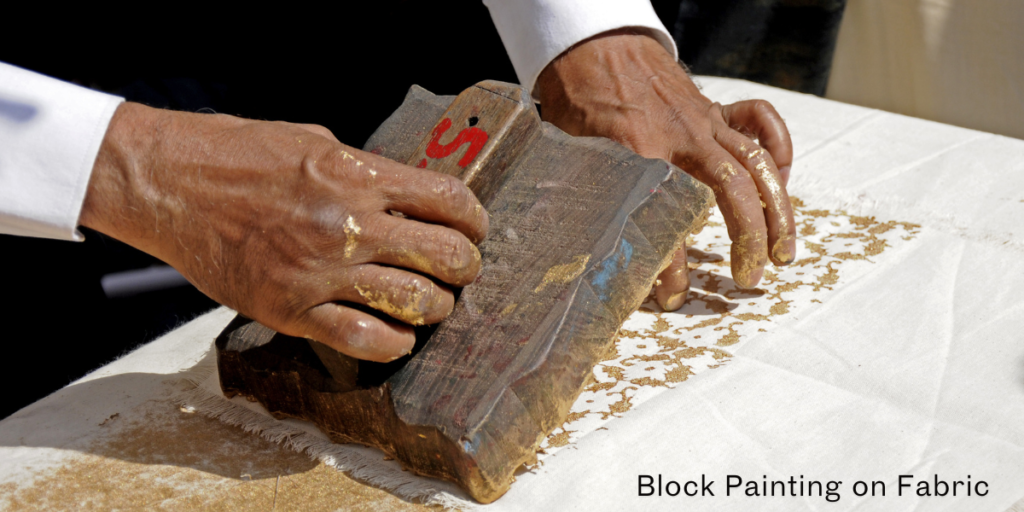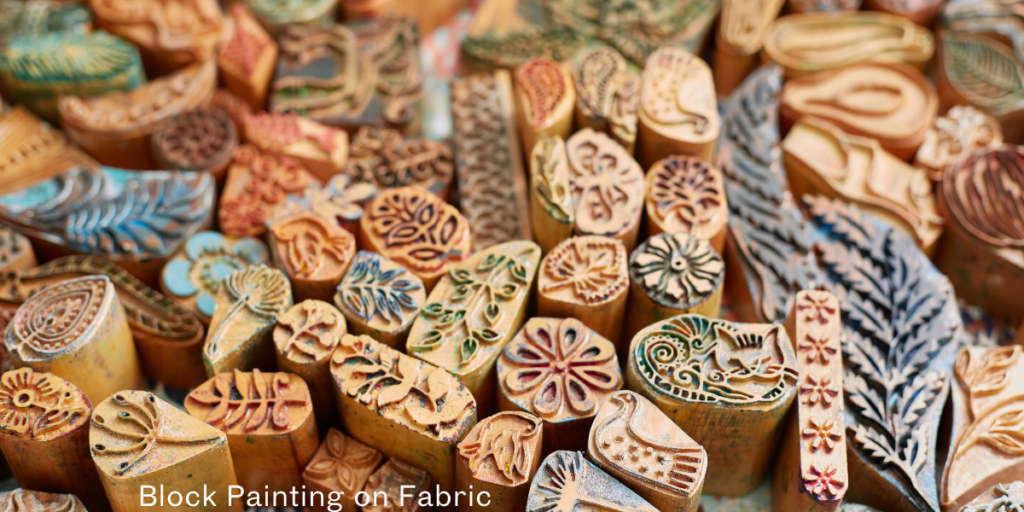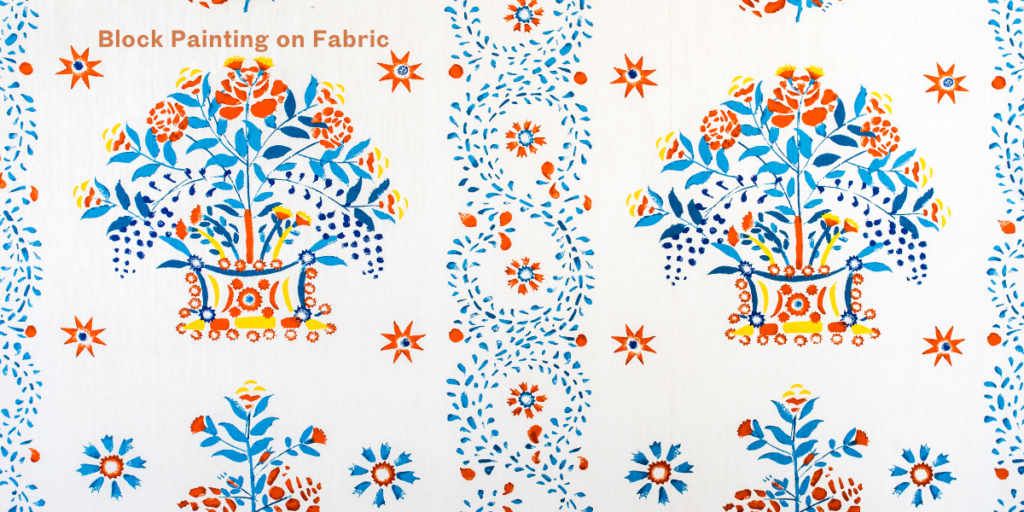Block Painting on Fabric: A Complete Guide to Creative Expression
Block painting on fabric is an ancient technique that combines creativity with a hands-on process, offering artists a unique way to decorate textiles. Whether you’re new to fabric art or looking to refine your skills, this versatile method allows for a wide range of artistic possibilities. From simple designs to intricate patterns, block painting can transform any fabric item, from clothing to home décor.
In this guide, we’ll explore the basics of block painting on fabric, the necessary materials, and various techniques to help you get started. We’ll also look at how you can use block painting to create one-of-a-kind designs that reflect your personality and style.
What is Block Painting on Fabric?

Block painting on fabric involves using a carved block (often made of wood, rubber, or other materials) to stamp or print paint onto fabric. The process is known for producing bold, crisp designs that stand out on any type of textile. It’s a form of relief printing that requires precision and patience, making it a popular technique among fabric artists and crafters.
Block painting can be done on a wide range of fabrics, including cotton, linen, silk, and wool. The designs can vary from geometric shapes to more intricate and detailed patterns, depending on the artist’s skill level and vision.
Materials Needed for Block Painting on Fabric
To begin your block painting on fabric project, you’ll need a few essential materials. Here’s a list to get you started:
- Fabric: Choose a fabric that suits your project. Natural fibers like cotton and linen are ideal because they absorb paint well and hold designs firmly.
- Fabric Paints or Textile Inks: These paints are specially formulated for use on fabrics. They adhere well to the fibers and stay durable after washing.
- Carved Blocks: Blocks come in different shapes, sizes, and materials. You can either purchase pre-carved blocks or carve your own. Wood, rubber, and linoleum are common materials used for block printing.
- Paint Rollers or Brushes: These are used to apply the fabric paint onto the block before printing it onto fabric. Rollers work well for even coverage, while brushes are more suited for detail work.
- Paper Towels or Fabric Scraps: These are helpful for cleaning up excess paint and testing designs.
- Protective Surface: Lay down a protective sheet or plastic under your fabric to avoid getting paint on unwanted areas.
How to Block Paint on Fabric: Step-by-Step Guide
With all the necessary materials ready, it’s time to begin crafting your masterpiece. Follow these steps to achieve stunning results.
Step 1: Prepare Your Fabric
Before you begin block painting, it’s essential to prepare your fabric. Wash and iron it to remove any dirt, wrinkles, or creases. A smooth, clean surface will help the paint adhere better and create sharp, crisp designs.
Step 2: Prepare Your Work Area
Set up a clean and protected workspace. Lay down a plastic sheet or newspaper to protect your table. You may also want to wear an apron to avoid staining your clothes.
Step 3: Apply Fabric Paint to the Block
Using a roller or brush, apply a thin layer of fabric paint onto the carved block. Be sure to cover the entire surface of the block evenly without excess paint. Too much paint can cause smudging or blurring when stamped onto the fabric.
Step 4: Press the Block onto Fabric
Carefully press the block onto your fabric, applying even pressure across the entire block. Ensure that the block makes full contact with the fabric to transfer the design evenly. Lift the block gently to reveal your print.
Step 5: Repeat and Layer
You can repeat this process as many times as necessary to create a pattern or design. Make sure to align the blocks properly if you want to create a seamless design. Allow the paint to dry completely between layers if you’re layering different colors or patterns.
Step 6: Set the Paint
Once you’ve completed your block painting design, allow the fabric to dry thoroughly. Most fabric paints need to be heat set to ensure their permanence and durability. Follow the manufacturer’s guidelines, usually involving an iron or heat press, to set the paint.
Techniques for Block Painting on Fabric

There are many ways to approach block painting, depending on the effect you want to achieve. Let’s look at some popular techniques:
1. Single-Block Prints
For a simple yet effective design, try using a single block to create a repeated pattern. This can work well for geometric shapes, floral patterns, or abstract designs.
2. Multi-Block Layering
Using multiple blocks to layer designs creates a more complex and intricate result. Start with a base design and build upon it with different shapes or colors to create depth and dimension.
3. Stencil and Block Hybrid
Combine block printing with stenciling for more detailed, fine-line work. After using your block, you can use stencils to add extra elements, such as fine lines or intricate details.
4. Gradual Color Transition
Block painting doesn’t just need to be one color. By gradually applying multiple colors to the block before stamping, you can create a gradient effect, giving your design a more dynamic and modern feel.
Creative Ideas for Block Painting on Fabric

Block painting can be used for a variety of fabric projects. Here are a few creative ideas to spark inspiration for your next block painting project:
1. Decorative Pillows
Use block painting to create custom pillow covers. Choose a design that complements your home décor and add a personal touch to your living room or bedroom.
2. Table Linens
Transform plain tablecloths, napkins, or placemats into stunning pieces by adding block-printed designs. Floral or geometric patterns can make your table settings look elegant and unique.
3. Tote Bags
Block printing on fabric tote bags is an excellent way to add flair to everyday accessories. Whether it’s a fun graphic or a delicate floral motif, block painting can give your bag a custom look.
4. Clothing
Create one-of-a-kind shirts, skirts, or scarves by block painting fabric. This is a great way to personalize your wardrobe with bold, unique designs.
5. Wall Art
Block painting on fabric can also be used to create wall hangings and tapestries. A large-scale design can make a striking visual statement in any room.
How to Care for Block Painted Fabric
Proper care will help preserve the beauty and longevity of your block-painted fabric projects. Here are some tips:
- Hand Wash or Machine Wash Gently: After setting the paint, always hand wash your fabric or use the gentle cycle on your washing machine.
- Cold Water: Use cold water to wash fabric that has been block painted to avoid fading the colors.
- Avoid Bleach: Bleach can strip away the paint, so it’s important to avoid using any harsh chemicals when cleaning your fabric.
- Iron Carefully: When ironing block-painted fabric, make sure to iron on the reverse side of the fabric to protect the design.
Frequently Asked Questions (FAQs)
1. Can I use regular paint for block painting on fabric?
While regular paint may work for some projects, it’s recommended to use fabric paint or textile ink for block painting. These paints are designed to bond with fabric fibers, ensuring durability and washability.
2. How do I clean my block printing blocks?
To clean your block printing blocks, wipe them with a damp cloth immediately after use to remove any excess paint. You can also rinse them under cold water if the paint is water-based. Allow the blocks to dry completely before storing.
3. Can I use block printing on any type of fabric?
Block printing works best on natural fabrics like cotton, linen, and silk. Synthetic fabrics may not absorb paint as effectively, but you can still use block printing if you use the appropriate fabric paint for synthetic materials.
4. How long does it take for fabric paint to dry?
Fabric paint usually dries within a few hours, but it’s important to follow the manufacturer’s instructions for drying and setting times. After painting, you should let the fabric dry completely before setting the paint with heat.
5. Can I block print on clothes?
Yes, block printing is a great way to add unique designs to clothing items such as shirts, skirts, and scarves. Just ensure that the fabric is pre-washed and properly prepped before starting your design.
Conclusion
Block painting on fabric is a timeless craft that offers endless possibilities for creativity and self-expression. Whether you’re making custom clothing, home décor, or gifts, the process is straightforward, enjoyable, and incredibly rewarding. By following the techniques outlined in this guide, you’ll be able to create beautiful, personalized fabric pieces that showcase your artistic vision.












Post Comment